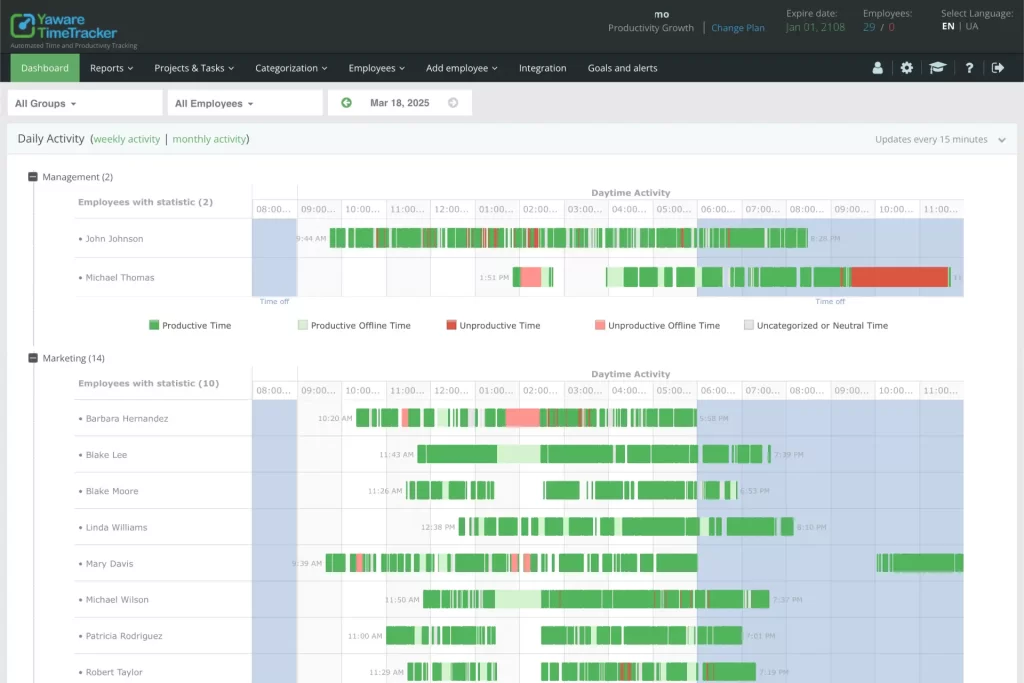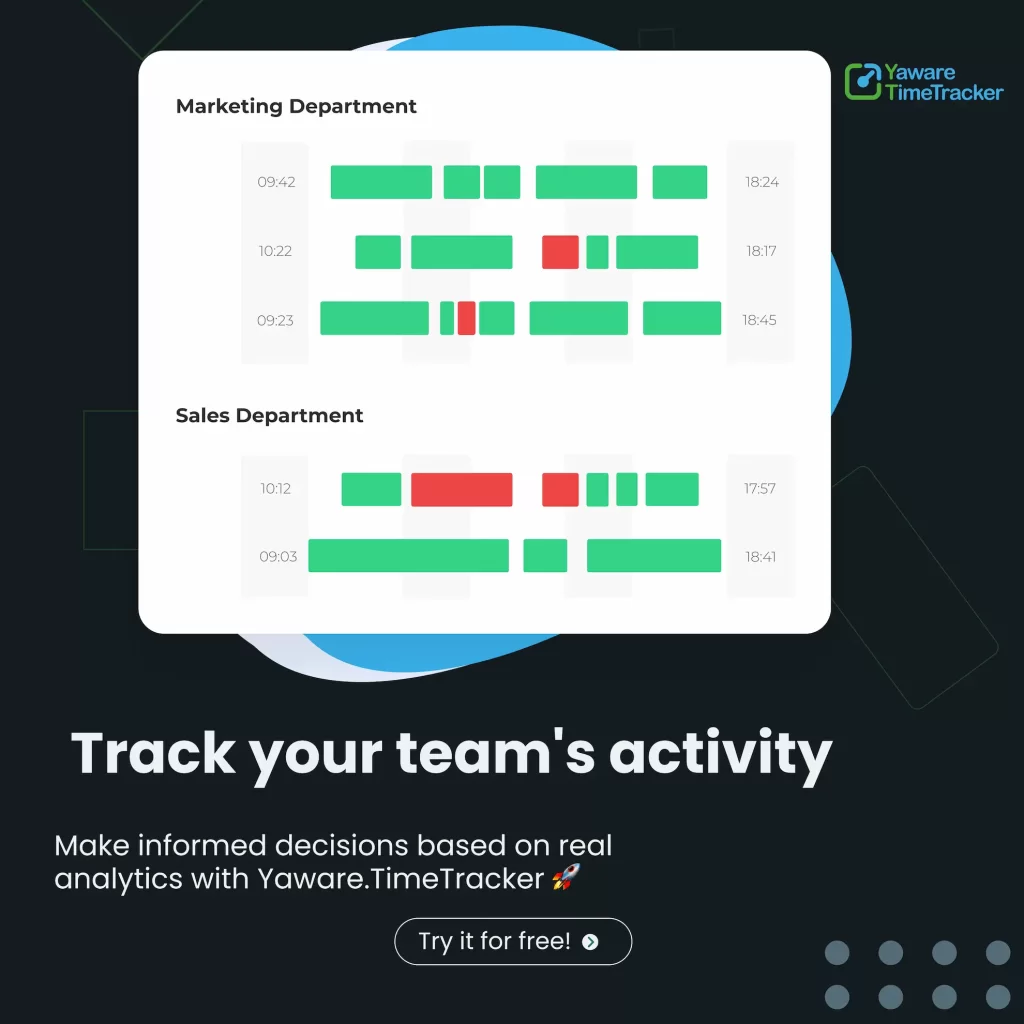To make the workday feel shorter, focus on engaging tasks, incorporate time management techniques, and leverage employee time tracking tools to structure workflows productively. Creating milestones and improving mental focus can shift your perception of time.
Why Does Time Move Slowly During the Workday?
For many professionals, especially in administrative or managerial roles, unproductive hours can feel disproportionately long. According to a Gallup report, only 36% of employees in the U.S. report feeling engaged at work. For the remaining majority, disengagement translates into sluggish hours, frequent distractions, and a distorted sense of time, all of which compound to reduce team efficiency and increase burnout risks.
When time drags, the underlying problem often has less to do with the actual clock and more with how one's brain perceives events. The mind “checks in” more frequently during periods of low stimulation, creating the illusion that time stands still. This perception directly affects performance, motivation, and — in broader terms — employee productivity.
The Business Cost of Perceived Time Slowness
For employers and managers, long-feeling workdays are more than just psychological discomfort; they can indicate wider systemic issues. Slow-moving time is often correlated with poor workforce engagement, slack task allocation, or a misalignment between goals and activities. Over time, this affects productivity metrics and delays deliverables. While salary costs remain constant, output drops significantly, eroding your competitive edge.
What Are Practical Ways to Make Time Go Faster at Work?
To alter the perception of time, it's essential to engage both attention and purpose. Neuroscience shows that time seems to pass quicker when you're absorbed in challenging yet attainable activities. Beyond personal effort, businesses can implement tools and frameworks to empower this focus across teams.
Use Employee Time Tracking to Add Structure to the Day
Structure is the antidote to a dragging workday. Integrating employee time tracking into your operational workflow provides more than just oversight — it creates rhythm. By segmenting time blocks, employees gain milestones to work toward. It also gives managers visibility into bottlenecks and unbalanced workloads that may be causing mental fatigue.

Using intelligent tracking can trigger micro-momentum. For example, if your team logs time spent on client-related tasks, they are more likely to stay accountable and focused within defined durations. The goal is not surveillance, but clarity.
Gamify Focus and Use Micro-Tasking Techniques
Monotony breaks engagement. Instead of tackling large tasks head-on, encourage teams to divide work into micro-sprints — 20–30-minute problem-solving blocks — with interim feedback points or short team updates. Organizations using employee productivity tracker systems often report increased deep work time by up to 25% over three months.
Gamified dashboards, progress bars, or time-bound benchmarks subtly nudge teams to pursue outputs over time spent. Behavioral psychology supports the idea that visible progress decreases the cognitive load of time-investment decisions.
What Is Time Tracking Software and Why Does It Matter?
Time tracking software helps organizations manage how working hours are allocated, recorded, and optimized. Unlike manual timesheets or Excel logs, modern platforms offer automation, team-level reporting, integration with project tools, and performance insights — all in real time. For leadership teams, this translates into data-driven decisions about productivity, cost control, and employee well-being.

Implementing such systems doesn’t just serve compliance or payroll. When employees know their time is being tracked intelligently — not intrusively — they tend to prioritize tasks, schedule focused work windows, and maintain better work-life boundaries.
Choose Purpose-Built Tools for Small Business Teams
For resource-strapped companies, using time tracking software for business ensures lean operations and prevents project time drain. Look for tools that allow easy setup, mobile-compatibility, team access control, and digestible analytics.
Startups and agencies can benefit from aligning time logs with client billing, internal cost centers, or strategic KPIs that go beyond traditional time clocks.
What Are the Most Effective Strategies to Regain Time Momentum?
The solution isn’t to work faster but smarter — by intentionally designing a day that feels “full” instead of “long.” The following list outlines practical strategies that business teams can adopt to shift this perception and accelerate time passage through meaningful engagement.
1️⃣ Time-Speed-Up Tactics That Actually Work
Here are five highly actionable strategies to make time feel faster — with direct applications for modern office environments and remote teams alike:
- Switch Activities Every 90 Minutes: The average attention span tends to dip after 75–90 minutes. Rotate across tasks or projects to maintain cognitive freshness.
- Use Visual Timelines: Create a visible daily agenda that breaks work into color-coded segments. Visibility influences perception and helps keep momentum.
- Block Distraction Time: Instead of suppressing distractions, allocate specific “distraction windows” to offset cognitive cravings without derailing tasks.
- Incorporate Movement: Stand-up meetings, walking breaks, or posture resets every hour re-stimulate thinking and disrupt time-idling loops.
- Track Wins, Not Just Time: Behavioral mapping shows that micro-rewards — such as achievements in a time tracker — accelerate perceived time by 35%.
Executed consistently, these tactics not only alter the experience of time but also drive higher engagement and collaborative energy across departments.
How Can Culture and Tech Combine to Improve Time Flow?
Technology alone won’t solve the problem if your workplace culture encourages reactive behavior and unmanaged workloads. That’s why syncing tools with mindset practices is fundamental. Move beyond installing automated time tracking software — integrate it as a part of a wider cultural shift.
Create Milestone-Based Collaboration Rituals
Introduce recurring rituals — like daily standups, project demos, or pre-week performance check-ins — that center around milestones, not just time used. This enables employees to see their impact progressively while keeping the sprint intervals dynamic.
- Ensure every team member knows what success looks like each day.
- Reward time well spent, not just clocked hours.
- Use dashboard snapshots for 360° visibility without micromanagement.
- Encourage skill-based scheduling: Align peak performance hours to critical-thinking tasks.
When time feels purposeful, it moves faster — and with it, your business does too.
Turning Time Perception into a Productivity Asset
Time perception is subjective, but it has measurable consequences across your business. By introducing structure, visibility, and mental stimulation — backed by modern employee time tracking software — you make the employee experience more fluid, focused, and fulfilling. In doing so, you accelerate both perceived and actual productivity across teams.
Want to stop losing hours to disengagement? Explore intelligent time tracking solutions designed to transform slow office days into momentum-rich workflows — and finally match time use with business value.

